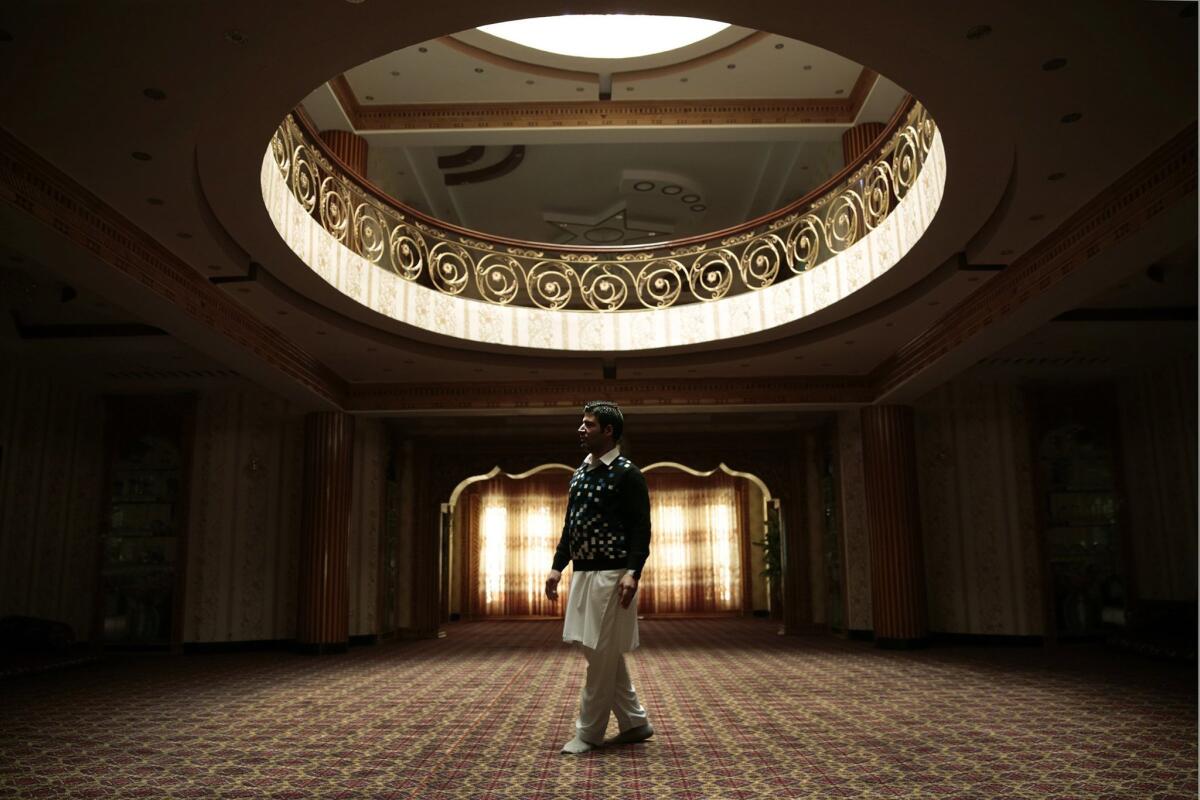Setting Times stories to music: From Junip to Sisters of Mercy

Although we had only two Column Ones in the paper this week, don’t fret – when you add the Christopher Dorner manhunt series, we had six Great Reads.
You might be saving up the series to read this weekend when you have more time, and this is your reminder not to let it languish like a stack of guilt-inducing New Yorkers.
Yes, you know the outcome. But you haven’t read anything like this.
Metro reporters have done more than 400 interviews over the 10 months since the manhunt, a number that staggers me. But here’s the wonderful alchemy of the series: the richness of details pulled from those interviews + some of our best writers = a beautiful, unexpected narrative.
And I’m getting ahead of myself, but I’ve been listening to the song “Line of Fire” so many times this week (see the Thursday story-song combo), I’d like to make a music-obsessive recommendation. Put it on repeat as you read all four parts – and even into the final part, running tomorrow. It’s a perfect soundtrack for the series.
Anyway, in these roundups of the week gone by, I’d like to offer the first paragraphs of each Great Read (or, as they’re known in print, Column One) -- maybe they’ll buy your eye and you can settle in for a good weekend read. And you’ll also get the songs that inspired me while editing the stories, or reading them later if my fellow editor Millie Quan ushered them through. A story-song combo!
#
A double killing, a vengeful plan, a wave of fear
The man emerged from a charcoal-gray pickup and approached the hotel check-in counter. He wanted a room and the Internet pass code. He was 6 feet tall, with a weightlifter’s build and military posture. But he could transform his soft, round face into a picture of amiability. He struck the night manager as personable and disarming.
Inside Room 116 of the Hi View Inn & Suites in Manhattan Beach, he stared at his Facebook page and a lifetime’s worth of grudges. It is not clear how long he had labored on the unusual document on the screen.
It was a rambling, free-associating screed in which he asserted firm opinions on politicians, journalists, comedians and television shows. It was a brew of hatreds, a sustained cry of self-pity and self-justification, and a blueprint.
One touch of a button would make it public, once people knew where to look.
It was 1:15 a.m. on Monday, Feb. 4.
Click.
#storysongs combo: “Judgement, Rage, Retribution and Thyme,” by Mudhoney. Like getting inside Dorner’s head. Spooky.
#
Traditional craftsmen restore Korean Friendship Bell
Chai Dong-hey is sandwiched between scaffolding and a 17-ton bronze bell on a bluff overlooking the Pacific Ocean. The white mask covering his mouth and nose pokes out just inches from tarnished metal.
His arm cocked at an 80-degree angle, the South Korean bell-master maneuvers a chisel into a crevice in an engraving of the Statue of Liberty on the bell. Then he draws out a small hammer — ready to carve out rust 37 years in the making.
Tap, tap, tap.
The bell issues a soft musical reply.
Gong, gong, gong.
Around him, other workers take buffers to the bell under the watchful eye of a foreman. By the midmorning, city workers back in a truck to remove bags full of waste, and at noon, the team retires for a simple lunch of barley rice.
After the break, Chai spreads his selection of small picks across a white cloth on the scaffolding. As he chips away at the edges of a rose, rusty brown gives way to glowing bronze.
Nearly 40 years ago, Chai’s mentor spent months casting the Korean Friendship Bell at the behest of the South Korean government and sent it to San Pedro as a present for the United States’ 200th birthday.
Now Chai is helping to rescue it.
“My teacher always spoke of this bell as a child he had given up for adoption. He was always concerned about its well-being, but there wasn’t much he could do, because it was so far away,” Chai says through a translator. “I always wanted to come here.”
#storysongs combo: “Ring My Bell,” by Anita Ward. What’s not to love about a little Monday morning disco?
#
A deadly threat ripples through the LAPD
Just after 2 p.m. at the LAPD’s sleek, 10-story glass tower, the phones began beeping furiously.
Police in Irvine, an hour south, had alerted their Los Angeles counterparts to a terrifying Facebook post. Its author, a disgraced LAPD patrolman, had vowed to murder his former colleagues en masse.
His targets ran through the ranks. Patrol officers were targets. Sergeants were targets. Captains were targets. The chief was a target. Families were targets.
It was Wednesday, Feb. 6. An impromptu war room sprang up on the fifth floor of LAPD’s downtown headquarters. Detectives in the robbery-homicide squad tore through Christopher Dorner’s online tirade and tallied the names on a white board. They quickly counted 30 people who needed protection.
Sirens screamed across freeways in every direction. About 200 cops went in the first wave of protection details. Specialized units were the easiest to mobilize, so gang squads went. Vice squads went. Twenty off-duty cops from the elite Metro division went. Ordinary patrol cops went.
The potential victims were scattered across thousands of square miles — across L.A. County’s far-flung suburbs, from its northern edge to deep inside Orange County, from the beach cities in the west to Riverside County in the east.
Every target would get a “scarecrow” detail: At least two cops, uniformed and visible. There was no time to ask permission of the many local police agencies whose territories the LAPD would be entering, no time to debate or negotiate.
Get there! commanders barked into radios and cellphones. Go! We’ll clean it up later!
#storysongs combo: “There Goes the Fear,” by Doves. A band I forget about, and then fall in love with again.
#
Betting big on a citadel for the Afghan elite
If Mohammed Ibrahim Caravan smells fear about Afghanistan’s future, he doesn’t show it.
He strolls around like a country squire in the glittering new gated community he helped build, dressed in a spotless white shalwar kameez tunic, stylish shades and polished wingtips.
“Worried?” the 28-year-old asked. “Hah — not me. I’m confident in the future. If you don’t invest in your own country, who will?”
Caravan’s company is plunging $160 million into the family-run Saleem Caravan City, with its rows of salmon-colored villas with balconies and rose gardens, like some ersatz Miami Beach condo community. He’s moved his family into a lavish 7,500-square-foot mansion with a pool, hot tub and guest kitchen.
Two hundred of the 300 homes in the 160-acre complex have already sold, Caravan says. Buyers love the swimming pool, the two mosques, the school, the shopping arcade — and especially the security walls, augmented by a high-tech security system and armed guards.
Many Afghans are panicking at the prospect of U.S. combat troops pulling out next year. Their confidence is battered by lingering uncertainty over a U.S.-Afghan security pact that, if rejected, would leave no U.S. troops in the country and cut billions of dollars in aid. As the Taliban insurgency roils the countryside, many investors are fleeing. Businessmen send their families to Turkey, Pakistan and Dubai, United Arab Emirates, for safety.
But Caravan is betting big on Afghanistan. He’s among a new breed of entrepreneurs here, young and energetic, in contrast to the paunchy warlords who dominated Kabul after the Taliban government was toppled in 2001.
Rising from the gray dirt on the capital’s gritty eastern shoulder, Caravan City’s walls protect the people who have the most to lose if Afghanistan’s government collapses. Many of the buyers of the homes — at $250,000 to $300,000 a pop, cash only — are top officials in the government, army and police.
These elites live in fear of car bombs, snipers, assassinations, kidnappings and roadside explosives. Unlike most Afghans, they can afford a secure gated community.
Caravan chooses to portray their home purchases as signs of confidence, not fear.
“They’re like me — they plan to live here with their families for a long time,” he said.
#storysongs combo: “Beautiful Future,” by Primal Scream. Yes, irony may be involved in the title.
#
On a night of fear, violent ambushes in the streets
Michael Crain’s wife demanded one thing of him, whenever he put on his uniform, secured his badge on his chest and patrolled the streets of Riverside overnight.
He had to text her that he was OK. If she woke she could glance at her phone and take reassurance. He thought the ritual was silly, because he might run into trouble five minutes later, but he did it anyway.
On the night of Wednesday, Feb. 6, as he did before every shift, Crain, 34, took pains to shed every vestige of his non-cop identity. He made sure there were no family photos in his wallet, in case it flopped open in a chase. He took off his wedding ring and put it on his nightstand.
In the streets, it was best to be a man without vulnerabilities.
Suspects would see a muscular, buzz-cut, 6-foot-3 ex-Marine. Not a father who coached his 10-year-old son’s baseball team, made his 4-year-old daughter breakfast every morning and learned to tie her ponytail. Not a man who liked the Food Network, Lynyrd Skynyrd and wearing zebra-striped platform shoes to disco parties.
A suspect had tried to follow him home once. This was safer.
Regina Crain had guessed he was ex-military the day they met, from the way he held out his chest and kept his hair high-and-tight. He had left the Marines before 9/11 and felt guilty he hadn’t stayed to fight, but she was glad he had avoided war. Her first husband had fought in Fallujah, and she had seen too many military funerals.
Tonight, she watched him pack his duffel bag for work — backup gun, badge clip, loose change, hair gel, boot polish, Tums. She knew that he liked the graveyard shift, because it was rarely dull, and that he would be disappointed if he came home saying, “I didn’t find any bad guys.”
#storysongs combo: “Line of Fire,” by Junip. Last count on repeated plays? About 20 (or is it 30?) for this one.
#
Charred truck on icy road draws pursuers to Big Bear
Det. Alex Collins was up early, with his wife and new baby, and found one story dominating the news. The reports made clear that Christopher Dorner was no longer hunting just the network of people he blamed for his firing from the LAPD. Fleeing east out of L.A. County, he was shooting anyone with a badge.
Collins was a boyish-looking 26 with an air of earnest innocence. He had married his high school sweetheart. He was the youngest of three brothers and had followed both of them into the San Bernardino County Sheriff’s Department.
Now, Collins thought of the suicides he had seen during his years patrolling Big Bear. People sought out the isolation of the mountains to end their lives. He wondered if that might be Dorner’s plan.
It was Thursday, Feb. 7. Collins wasn’t supposed to be working. He had been on leave for two and a half weeks, for his son’s birth. His hair was longer than he liked it, and he had grown a beard.
It was still morning when his phone rang. It was his oldest brother, a patrol sergeant in Big Bear. He had information that had not yet made the news.
“Hey, I think we found Dorner’s truck,” he whispered. He was calling from an ice-covered mountain road where an abandoned Nissan Titan sat charred and smoldering.
Collins felt the impulse to go in. He called his other brother, who was on the SWAT team. Over the phone, he could hear him flooring his accelerator as he raced up the mountain.
Collins shaved. He put on his suit and tie.
His mom called to check on the baby. He told her he was going to follow his brothers up the mountain. He would not be able to live with himself if one of them got hurt and he was not there to help.
She sounded nervous. All three of her sons would be hunting a cop killer.
“I gotta go,” he said.
#storysongs combo: “Driven Like the Snow,” by Sisters of Mercy. The image in the video fits the mood of the story as well as the song (which, I must note, has one Anglo-Saxon word).
#
If you have ideas for story-song pairings of your own, tweet the title and artist to @karihow or @LATgreatreads with the hashtag #storysongs.
More to Read
Sign up for Essential California
The most important California stories and recommendations in your inbox every morning.
You may occasionally receive promotional content from the Los Angeles Times.










